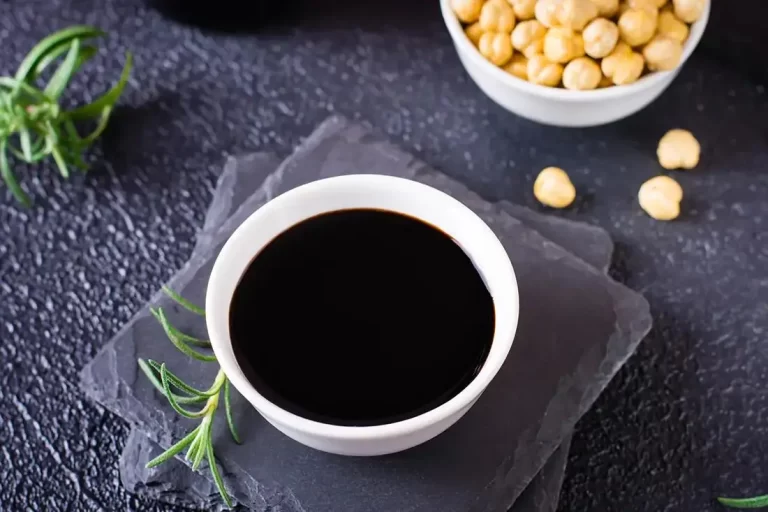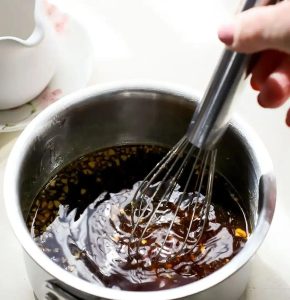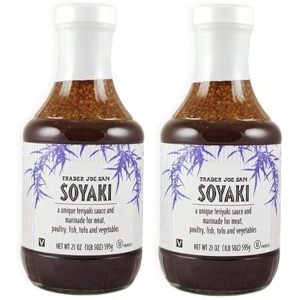Table of Contents
If you’re a fan of Trader Joe’s Soyaki Sauce, you know it’s one of the most popular products from Trader Joe’s grocery store, celebrated for its perfect balance of soy sauce and teriyaki flavors. This sweet, savory, and slightly tangy sauce, packed with sesame seeds, ginger, and garlic, is a versatile kitchen staple. Whether you’re using it for marinating, stir-frying, or dipping, learning how to make Trader Joes Soyaki Sauce allows you to recreate this iconic sauce in your own kitchen, with customizable flavors to suit your taste.

How to Make Trader Joes Soyaki Sauce
Ingredients
To create an authentic homemade version of Trader Joe’s Soyaki Sauce recipe, you’ll need the following ingredients. Each one plays an important role in achieving the desired balance of sweet, salty, and savory flavors.
- 1/2 cup soy sauce (preferably low-sodium)
- 1/4 cup mirin (a sweet Japanese rice wine)
- 1/4 cup pineapple juice (for natural sweetness)
- 2 tablespoons sesame oil
- 1 tablespoon rice vinegar (for a slight tang)
- 2 tablespoons brown sugar (for sweetness)
- 1 tablespoon honey (to enhance the sweetness and add thickness)
- 4 cloves garlic, minced
- 2 teaspoons fresh ginger, grated
- 1 tablespoon sesame seeds (for added texture and flavor)
- 1 tablespoon cornstarch (optional, for thickening)
- 1/4 cup water (optional, to adjust consistency)
This list closely mirrors the ingredients used in Trader Joe’s version and gives you room to tweak according to personal preferences.

Instructions to make Trader Joes Soyaki Sauce
Making your homemade Soyaki Sauce is simple and requires just a few steps.
Step 1: Prepare the Ingredients
Start by preparing all your ingredients. Mince the garlic, grate the ginger, and measure out the rest of the items. This will streamline the cooking process.
Step 2: Combine the Wet Ingredients
In a small saucepan, combine soy sauce, mirin, pineapple juice, sesame oil, rice vinegar, brown sugar, and honey. Stir everything together to ensure the sugar dissolves and all ingredients are well mixed.
Step 3: Add the Aromatics
Add the minced garlic and grated ginger to the saucepan. These aromatics will infuse the sauce with a rich, bold flavor.
Step 4: Simmer the Sauce
Place the saucepan over medium heat and bring the mixture to a light simmer. Allow it to cook for 5-7 minutes, stirring occasionally. This helps to meld the flavors and reduce the sauce slightly.
Step 5: Thicken the Sauce (Optional)
If you prefer a thicker consistency, you can mix 1 tablespoon of cornstarch with 1/4 cup of water to make a slurry. Add this mixture to the saucepan and stir until the sauce thickens. This step is optional, depending on your desired texture.
Step 6: Add the Sesame Seeds
Once the sauce reaches your desired consistency, remove it from the heat and stir in sesame seeds for an authentic Soyaki flavor.
Step 7: Cool and Store
Allow the sauce to cool before transferring it to an airtight container. Store your homemade Trader Joe’s Soyaki Sauce in the refrigerator for up to two weeks.

3. Tips for perfect Soyaki Sauce
Creating the perfect homemade Soyaki Sauce recipe requires a few tips to elevate the flavors and achieve the ideal texture:
- Balance sweetness and saltiness: Adjust the sweetness or saltiness by adding more honey or soy sauce based on your taste preferences.
- Use fresh ingredients: Fresh ginger and garlic are essential for a vibrant, aromatic sauce.
- Experiment with thickness: You can control the thickness of your sauce by adjusting the cornstarch slurry. For a thinner sauce, omit the slurry; for a thicker one, add more.
- Allow flavors to meld: For a richer taste, let the sauce sit overnight in the refrigerator. This allows the flavors to deepen and integrate.
4. Variations
The beauty of making your own Trader Joe’s Soyaki Sauce is the ability to customize it to your liking. Here are a few variations you can try:
- Spicy Soyaki Sauce: Add some heat by incorporating 1-2 teaspoons of red pepper flakes or Sriracha into the sauce.
- Citrus Soyaki: Enhance the brightness by adding 1 tablespoon of orange juice or zest for a zesty kick.
- Gluten-Free Soyaki: Substitute regular soy sauce with gluten-free tamari to make the sauce suitable for those with gluten sensitivities.
- Low-Sugar Version: If you want a healthier version, reduce the amount of brown sugar and honey, or swap them for a sugar-free sweetener like monk fruit or Stevia.
5. Where to Use Trader Joe’s Soyaki Sauce
This Soyaki Sauce is incredibly versatile and can be used in various dishes. Here are a few ideas on how you can enjoy it:
- Marinade for Meat or Tofu: Use it as a marinade for chicken, beef, pork, or tofu. The sauce penetrates deeply into the proteins, adding a burst of flavor.
- Stir-fry Sauce: Incorporate it into your favorite stir-fry recipes for a quick and easy dinner with vegetables, meat, or seafood.
- Dipping Sauce: Serve it alongside potstickers, spring rolls, or sushi as a dipping sauce.
- Grilled Vegetables: Drizzle over grilled vegetables like zucchini, mushrooms, and bell peppers for added flavor.
- Glaze for Seafood: Brush it over grilled or baked fish, like salmon or cod, for a tangy-sweet finish.

6. FAQs
Can I make this sauce ahead of time?
Yes! You can make this sauce in advance and store it in the refrigerator for up to two weeks. Just make sure to store it in an airtight container.
Can I freeze Soyaki Sauce?
Yes, you can freeze Homemade Soyaki Sauce. Pour the sauce into an airtight container or freezer bag and freeze for up to three months. Thaw it in the refrigerator overnight before use.
What can I do if my sauce is too salty?
If the sauce tastes too salty, add more pineapple juice or a bit of water to dilute the saltiness. You can also increase the amount of sweetener.
Is this recipe gluten-free?
To make the sauce gluten-free, simply use tamari or another gluten-free soy sauce alternative.
Can I make it without sesame oil?
Yes, you can leave out the sesame oil if you’re allergic or don’t have it on hand. However, sesame oil adds a nutty richness, so try to replace it with another oil, like olive oil, if possible.
7. Ingredient Substitutes
If you’re missing an ingredient or want to make modifications, here are some great substitutions for this Soyaki Sauce recipe:
- Soy Sauce Substitute: Use tamari or coconut aminos for a gluten-free or soy-free alternative.
- Mirin Substitute: Replace mirin with dry sherry or a combination of sugar and rice vinegar for a similar flavor.
- Pineapple Juice Substitute: If you don’t have pineapple juice, use orange juice or apple juice for sweetness.
- Honey Substitute: Agave syrup, maple syrup, or brown sugar can replace honey.
8. Nutrition
The following is the approximate nutrition breakdown per tablespoon of Homemade Soyaki Sauce:
- Calories: 25
- Carbohydrates: 3g
- Sugar: 2g
- Protein: 1g
- Fat: 1g
- Sodium: 300mg
These values may vary slightly based on the specific brands of ingredients you use. The sauce is relatively low in calories but can be high in sodium, especially if you don’t use low-sodium soy sauce.
Conclusion
Making your own Trader Joe’s Soyaki Sauce at home is not only simple but also allows for full control over the ingredients. Whether you’re using it as a marinade, dipping sauce, or stir-fry base, this sauce will bring out bold, complex flavors in any dish. By following this How to Make Homemade Trader Joe’s Soyaki Sauce recipe, you’ll have a delicious and versatile sauce that can elevate your meals. Enjoy experimenting with different variations and using it in your favorite recipes!






